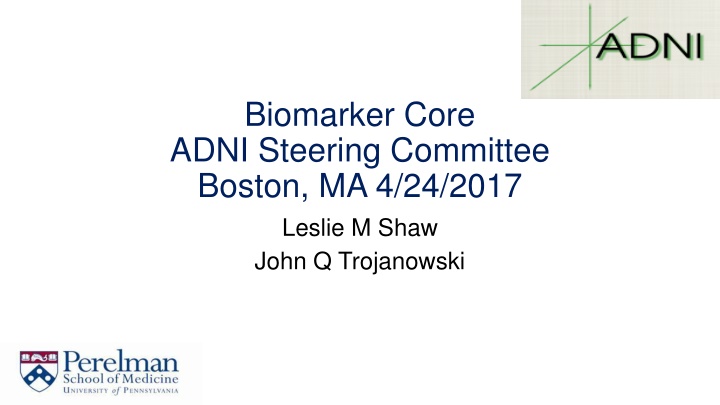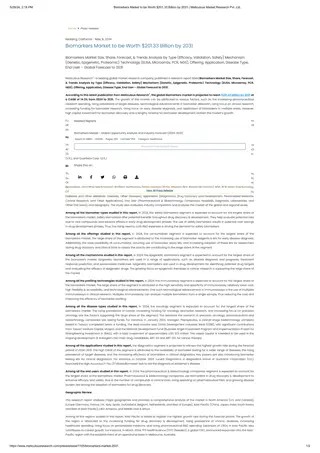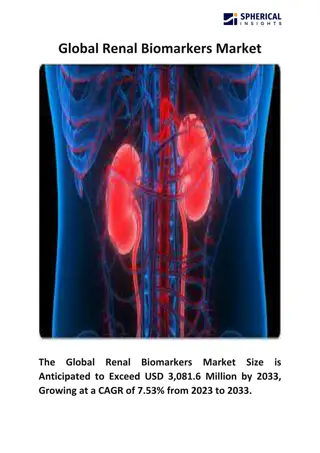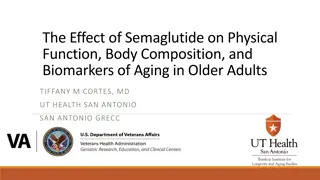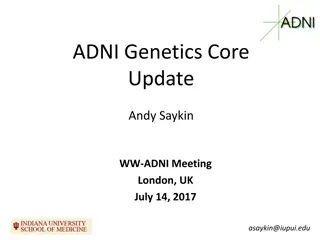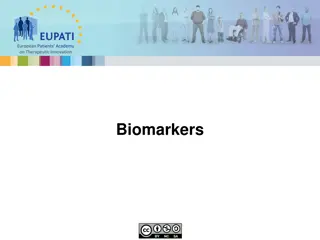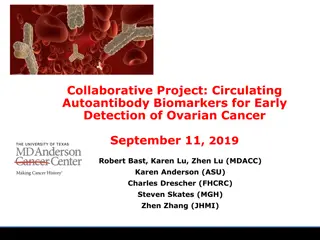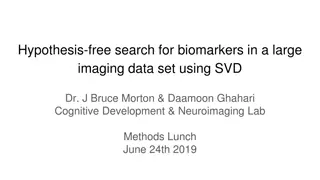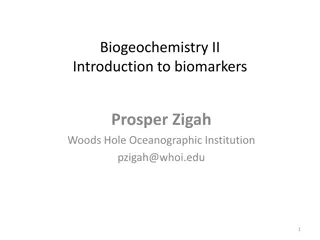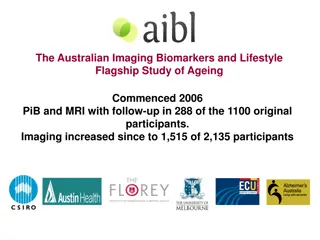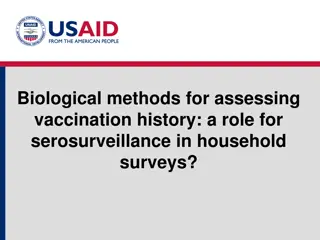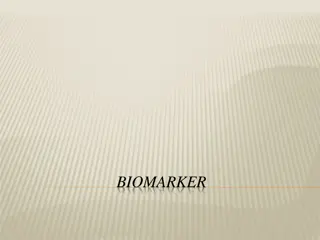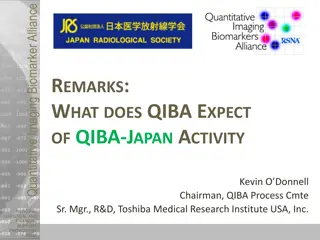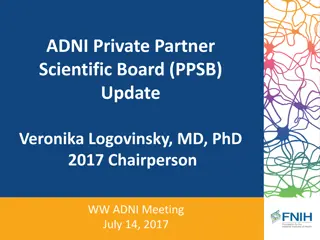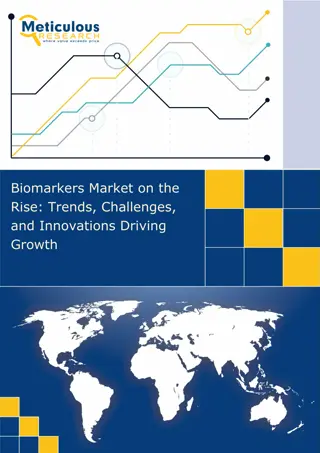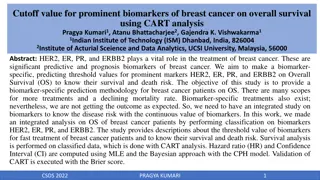New Biomarkers in ADNI Studies
Biomarker research in Alzheimer's Disease and Related Dementias often focuses on understanding disease components like SPs, NFTs, LBs, Tau, TDP-43, and Alpha-synuclein. This study explores multi-proteinopathies in various neurodegenerative disorders like AD, FTD, ALS, PD, PDD, DLB, MSA, and Prion Diseases, shedding light on the complex nature of these conditions.
Download Presentation

Please find below an Image/Link to download the presentation.
The content on the website is provided AS IS for your information and personal use only. It may not be sold, licensed, or shared on other websites without obtaining consent from the author.If you encounter any issues during the download, it is possible that the publisher has removed the file from their server.
You are allowed to download the files provided on this website for personal or commercial use, subject to the condition that they are used lawfully. All files are the property of their respective owners.
The content on the website is provided AS IS for your information and personal use only. It may not be sold, licensed, or shared on other websites without obtaining consent from the author.
E N D
Presentation Transcript
Biomarker Core ADNI Steering Committee Boston, MA 4/24/2017 Leslie M Shaw John Q Trojanowski
New biomarkers in NIA/ADNI/RARC-approved studies Biomarker Fluid # ADNI study Investigator Plasma NFL & Tau diag/prognosis 3,000+ ADNIGO/2 BL + longitudinal HZetterberg;NMattsson;Kblennow; Sweden CSF sTREM2 1007 ADNI1/GO/2 BL + longitudinal shared samples MSuares-Calvert,MEwers; DZNE, Germany CSF sTREM2 levels & AD; IA 1007 ADNI1/GO/2 BL + longitudinal Cruchaga; Wash U Serum Metabolic networks 905 Studies in ADNIGO/2 BL samples RKaddoura-Daouk; Duke Univ, A 1-42/1-40;ELISA plasma 764 ADNI 1, GO, 2 in BL & longitudinal ISherriff; Araclon Biotech Metabolic networks serum 833 Studies in ADNI1 BL samples; data uploaded RKaddoura-Daouk; Duke Univ, SNAP25 & neurogranin CSF 612 Longitudinal samples AFagan; Wash University T-& Phos- -SYN; IA CSF 567 Longitudinal samples, to be uploaded JZhang; University of Wash Vilip 1; YKL-40; IA CSF 612 Longitudinal samples, publication planned AFagan; Wash University plasma Tau; IA 595 BL ADNI1; publication KBlennow; Sahlgrenska UHosp Neurogranin; NFL; IA CSF 416 BL ADNI1; multiple publications KBlennow; Sahlgrenska UHosp BL ADNI1; 221 proteins;publication;another planned Proteome/ MRM/MSMS CSF 306 ADNI PPSB/FNIH; LHonigsberg plasma Proteome/RBM 1,065 BL & yr1; multiple publications HSoares;Pfizer/PPSB/FNIH Proteome/RBM CSF 317 BL ADNI1; multiple publications WPotter,etal/PPSB/FNIH BACE & sAPP CSF 402 BL ADNI1; recent publication MSavage;merck/PPSB/FNIH -Synuclein;xMAP CSF 390 BL ADNI1; several publications JZhang; University of Wash
Alzheimers Disease (AD) And Related Dementias (ADRD) Often Show Comorbid Multi-Proteinopathies DISEASE LESIONS COMPONENTS SPs (100%) NFTs (100%) LBs (-50%) TDP-43 (-50%) A Tau Alpha-synuclein TDP-43 Alzheimer s Disease (AD) The most common multi-proteinopathy Tau (FTLD-Tau), TDP-43 (FTLD- TDP), FTLD-FUS Frontotemporal Degeneration (FTD) Inclusions Amyotrophic Lateral Sclerosis (ALS) Inclusions TDP-43, FUS, Tau, SOD1 Parkinson s Disease (PD) -/+ Dementia (PDD) & Dementia With Lewy Bodies (DLB) LBs, SPs, NFTs Alpha-synuclein, A , Tau Multiple System Atrophy (MSA) GCIs Alpha-Synuclein Prion Diseases SPs Prions, Tau, A , Alpha-synuclein Trinucleotide repeat diseases Inclusions Expanded polyglumatine repeats
Incidental Alpha-synuclein (Syn) And TDP-43 (TDP) Pathologies Are Rare In PART/NA, But Very Common In AD Such That Only 35% Of AD Patients In Our CNDR Brain Bank Have Pure Plaque And Tangle only AD. PART/Ageing AD +tdp 16% +syn 5% AD 35% +AD 16% +syn+tdp 22% NFTs only 75% +syn 27% +tdp 2% +tdp+syn 2%
TDP-43: Potential Use Useful for diagnosis of AD and related dementias (ADRD) Useful treatment selection for ADRD Useful for formulating prognoses for ADRD Useful for monitoring disease progression for ADRD Useful for monitoring disease modifying therapies when available for ADRD Acknowledgements: Many thanks to Linda K. Kwong, Yan Xu, Dawn M. Riddle and Virginia M.-Y. Lee for all their efforts on TDP-43 antibody production and ELISA development and to John Robinson, Maria Corrada and Claudia Kawas for their efforts on the comorbid pathology studies. These studies were made possible through grants from NIA/NINDS and the Koller Family Foundation as well as the support of the Families of our patients. 5
Why automation of CSF biomarkers? Eliminate as many manual steps as possible Promote best possible precision & accuracy Within-lab Between-labs using common samples, eg AlzAssn QC program Same study population and pre-analytical protocol, eg, treatment trials Different study populations and pre-analytical protocols, eg, ADNI, BioFINDER Improved lot-to-lot performance Enable IVD test approval clinical laboratory test Can provide both accurate and precise data Use in treatment trials, especially international where local laboratory is essential(eg, China).
Between-labs performance: Alz Association QC program KBlennow
ADNI3 Aims for Biomarker Core Aim 2:Provide highly standardized A 1-42, t-tau and p-tau181 measurements on all ADNI subject CSF samples using the Roche automated immunoassay platform(Cobas e601) and immunoassay reagents. In addition provide immunoassay-independent measurements of A species (A 1-42, A 1-40and A 1-38) using a validated reference 2D-UPLC/tandem mass spectrometry method in baseline and longitudinal CSF samples. Continue collaboration with other investigators to achieve harmonization of these measurements across centers and different platforms in support of their use in clinical trials. Change: from manual RUO immunoassay to fully automated immunoassay platform for ADNI 3: Due diligence: started Q4, 2014, in consultation with ADNI Exec Comm & NIA & PPSB/BBWG/DDWG. Selection: in consultation with ADNI PPSB/BBWG/DDWG, chaired by Johan Luthman. Roche Elecsys: validation for A 1-42 in CSF completed. External QC: Participation in the AlzAssn CSF QC program for A 1-42 Validation of t-tau and p-tau181: completed FALL, 2016 Analyses of all ADNI CSFs: lateFALL, 2016-early WINTER, 2017 Continued collaboration: with Kaj Blennow & AlzAssn and IFCC CSF WGs to produce certified reference CSF pools with assigned reference A 1-42 concentration values, measured with reference 2D-UPLC/tandem mass spectrometry, to provide certified reference materials for validation of A 1-42 calibrators--promoting harmonization across assay platforms. Review & participate in: studies of pre-analytical factors for CSF collection.
Analysis of 2401 ADNI1/GO/2 CSF samples 2401 ADNI pristine CSFs, collected from 9/7/2005 to 7/25/2016 were analyzed in 36 analytical runs at UPenn from 11-17-2016 to 1-20-2017: 402 ADNI1 BASELINE; 819 ADNIGO/2 BASELINE ADNI1: 112 HC, 192 MCI, 98 AD ADNIGO/2: 154 LMCI, 132 AD 160 HC, 96 SMC, 277 EMCI,
Analyses of ADNI1/GO/2 CSF A1-42, t-tau, p-tau181 using the Roche Elecsys fully automated immunoassay platform Rationale for moving from RUO to full automation Validation of A 1-42 for precision, accuracy, and clinical performance General statistics for A 1-42, t-tau, p-tau181, t-tau/A 1-42, p-tau181/A 1-42 in the ADNI1/GO/2 CSF samples Histogram distributions for A 1-42, t-tau/A 1-42, p-tau181 Distributions based on FBP amyloid- PET + or Cutpoint determinations Collaborative study with BioFINDER Concordance with FBP amyloid- PET Prediction of cognitive decline(CDRsob) Summary
Method validation studies at UPenn: Roche Elecsys immunoassay CSF A 1-42: Analytical studies Short and long-term precision studies Linearity Comparison of Elecsys between UPenn and Roche Comparison with a reference mrm/mass spectrometry method Comparison with the RUO AlzBio3 immunoassay Two sets of non-ADNI CSF samples utilized(250 residual CSF from routine clinic patients; 129 CSFs from the UPenn ADRC) ROC analyses for AD vs HC in 129 CSFs from the UPenn ADRC(62 AD, 67 HC)
SUMMARY UPENN/Roche comparison (both use Roche Elecsys,15 CSF pools): PB regression Y = 1.04X - 24.8; Pearson s r = 0.994 Bias at cut-off <10% Slope is within 1.0 0.1 Elecsys, AlzBio3 and LC-MS Abeta(1-42) measurements were performed for 250 samples from data set A and 129 samples from data set B Data set A and B were not pooled as AlzBio3 measurements differed between the two sample sets Correlation between Elecsys and AlzBio3: Spearman s rho 0.86(A)/0.82(B); some non-linearity Elecsys and LC-MS: Spearman s rho 0.95(A)/0.96(B); Linear relationship details in following ppt. LC-MS and AlzBio3: Spearman s rho 0.87(A)/0.77(B); some non-linearity ROC-AUC analysis within the data set B(AD vs HC): equivalent performance of all 3 methods *Toronto 2016 AAIC meeting poster & included in an AAIC symposium talk.
Roche Elecsys versus LC/MS for ADNI1 BASELINE CSF A1-42 Confirms finding from UPenn Method Comparison study: linear relationship and approximately 1:1
Comparisons between Roche Elecsys & AlzBio3 immunoassays for ADNI1/GO/2 CSFs. A 1-42 t-tau p-tau181
ADNI1 BASELINE CSF A1-42, t-tau, p-tau181& ratios A 1-42 t-tau/A 1-42 p-tau181/A 1-42 % 4+ ADNI1 t-tau p-tau181 (pg/mL) (pg/mL) (pg/mL) AD 72.6 Median 548 349 34 0.62 0.063 N=95 mean SD 610 242 359 130 36 15 0.65 0.28 0.066 0.032 95% CI 305-1125 154-687 13-73 0.15-1.42 0.012-0.14 MCI 56.6 633 294 28 0.50 0.050 Median 741 338 312 124 31 14 0.51 0.30 0.052 0.033 N=176mean SD 292-1624 140-599 12-63 0.12-1.22 0.010-0.13 95% CI NC 26.4 989 218 20 0.18 0.017 Median 1018 397 239 84 22 9 0.27 0.18 0.026 0.019 N=91 mean SD 394-1640 112-444 11-43 0.11-0.73 0.0089-0.079 95% CI
ADNIGO/2 CSF BASELINE A1-42, t-tau, p-tau181 & ratios ADNIGO/2 A 1-42 t-tau p-tau181 t-tau/A 1-42 p-tau181/A 1-42 % 4+ (pg/mL) (pg/mL) (pg/mL) AD Median 68.5 594 334 33 0.58 0.058 649 257 375 155 37 16 0.64 0.32 0.064 0.034 N=127 mean SD 309-1375 170-750 15-76 0.18-1.42 0.014-0.15 95% CI LMCI Median 60.9 756 286 28 0.50 0.050 800 285 308 136 30 15 0.51 0.30 0.052 0.033 N=138 mean SD 340-1457 115-577 10-63 0.12-1.22 0.010-0.13 95% CI EMCI Median 49.4 865 234 20 0.27 0.025 943 355 256 122 22 9 0.33 0.26 0.033 0.029 N=122 mean SD 382-1659 117-582 11-43 0.09-0.95 0.0082-0.106 95% CI SMC Median 43.7 1111 218 19 0.19 0.017 1079 374 241 94 22 10 0.25 0.16 0.024 0.017 N=71 mean SD 454-1670 107-462 10-49 0.10-0.67 0.0084-0.071 95% CI 33.0 NC Median 974 211 19 0.21 0.020 1013 379 238 92 22 9 0.27 0.18 0.0260.019 N=109 mean SD 342-1686 110-469 10-48 0.09-0.69 0.0086-0.073 95% CI
A1-42 all values 1248 1324 1052 1291 793* 658 617 562 Numbers inside the boxes are the respective median values for BL A 1-42 in pg/mL placed above the median value horizontal line. *p<0.005 for LMCI ADNIGO+2 vs ADNI1; p=0.11 for NL ADNIGO+2 vs ADNI1; p=0.23 for AD ADNIGO+2 vs ADNI1
t-tau 349 334 294 286 234 218 218 211 Numbers inside the boxes are the respective median values for BL t-tau in pg/mL placed above the median value horizontal line. P=0.81 for NL ADNIGO+2 vs ADNI1; p=0.51 for MCI ADNIGO+2 vs ADNI1; p=0.81 for AD ADNIGO+2 vs ADNI1
p-tau181 34.0 33.2 28.4 27.6 20.7 19.9 19.3 19.3 Numbers inside the boxes are the respective median values for p-tau181 in pg/mL placed above the median value horizontal line. *p=0.71 for ADNIGO+2 vs ADNI1; p=0.43 for MCI ADNIGO+2 vs ADNI1; p=0.88 for AD ADNIGO+2 vs ADNI1.
Frequency distribution plots: upper are mixture model plots, lower are FBP+ and FBP- for ADNI SMC/EMCI/LMCI/AD ptau181/A 1-42 tau/A 1-42 A 1-42
ROC Curves for SMC+EMCI+LMCI+AD CSF biomarkers using FBP PET+/- as the clinical endpoint* AUC values: p-tau/A 1-42 t-tau/A 1-42 A 1-42 p-tau181 t-tau Sens Spec Eff 0.944 91.3% 88.5% 90.2% 0.940 91.6% 87.4% 89.9% 0.889 86.7% 81.7% 84.6% 0.845 79.9% 74.8% 77.8% 0.803 74.0% 72.9% 73.5% Cutpoint values: p-tau/A 1-42 t-tau/A 1-42 A 1-42 p-tau181 t-tau 0.021 0.222 980 pg/mL 21.8 pg/mL 245 pg/mL *SUVR of 1.1 used: Landau and Jagust
Cutpoint assessments for CSF A1-42, t-tau & p-tau181 in ADNI ROC with FBP PET as the endpoint: A 1-42, 980 pg/mL t-tau/A 1-42, 0.22 t-tau, 245 pg/mL p-tau181/A 1-42, 0.021 p-tau181, 21.8 pg/mL Disease-independent mixture modeling A 1-42, 1016 pg/mL t-tau/A 1-42, 0.19 t-tau, NA p-tau181/A 1-42, 0.018 p-tau181, NA Prediction from BioFINDER study based on pre-analytic differences A 1-42, 880 pg/mL t-tau/A 1-42, 0.33 t-tau, 270 pg/mL p-tau181/A 1-42, 0.028 p-tau181, 24 pg/mL
Concordance plots for FBP vs CSF A1-42 in ADNIGO/2 SMC, EMCI, LMCI & AD participants at BASELINE
Concordance plots for FBP vs CSF tau/A1-42 in ADNIGO/2 SMC, EMCI, LMCI & AD participants at BASELINE
Concordance plots for FBP vs CSF ptau/A1-42 in ADNIGO/2 participants at BASELINE
Prediction of cognitive decline( Prediction of cognitive decline(CDRsob CDRsob) in ADNIGO/2 LMCI subjects ) in ADNIGO/2 LMCI subjects A 1-42 t-tau/A 1-42 riskTAA2i Vertical red arrow points to regression line for CDRsob values associated with A 1-42 values below cutpoint value, t-tau/A 1-42 values above cutpoint value, and logistic regression model(includes A 1-42, t-tau and APOE 4 allele # as covariates) values above cutpoint value.
Summary Summary Roche Elecsys immunoassays for Abeta1-42, t-tau and p-tau181 completed for 2401 ADNI1/GO/2 CSFs, and uploaded on the ADNI/LONI website, March 2017 Precision and accuracy validations completed according to CLSI EP05 General stats, Frequency distributions, mixture modeling & ROC with FBP PET as endpt described The t-tau/A 1-42 and p-tau181/A 1-42 ratios outperformed A 1-42 alone for clinical utilities based on: Comparisons to FBP PET in ROC analyses Concordance with FBP PET Disease-independent mixture modeling This observation is consistent with the BioFINDER study(using Roche platform/flutemetmol PET) as well as multiple other studies that used other immunoassay platforms and clinical endpoints: Seeburger, 2015(OPTIMA study, N=227, autopsy-based diagnosis); Fagan, 2011(HASD, PIB PET based endpoint, N=103); Palmqvist, 2015(BioFINDER, Flutemetamol PET, N=366) Mechanism possibilities: normalization of variance; tau abnormality adds to predictive performance, further studies needed Cutpoint assessments: ROC with FBP as endpoint; disease independent mixture modeling; extrapolation from BioFINDER study based on pre-analytical differences Prediction performance of BASELINE CSF AD biomarkers for cognitive decline documentation Continue ongoing work with ADNI and other studies toward goal of defining universal cutpoints for A 1-42, t-tau and p-tau181. Continue to work with colleagues on pre-analytical and other factors to help minimize and control these sources of variability Implement in ADNI3 Collaboration on multimodal studies that include CSF, imaging, genetic, clinical parameters
ACKNOWLEDGEMENTS Biomarker Research Lab Magdalena Korecka Michal Figurski Magdalena Brylska Teresa Waligorska Leona Fields Jacob Alexander Ju Hee Kang CNDR/ADRC John Trojanowski Virginia M-Y Lee Steve Arnold Murray Grossman Jon Toledo Alice Chen-Plotkin William Hu Anne Fagan Hugo Vanderstichele Kaj Blennow Henrik Zetterberg Chris Clark* Manu Vandijck John Lawson Udo Eichenlaub Tobias Bittner The Roche team Robert Dean Holly Soares Adam Simon Eric Siemers Piotr Lewczuk William Potter Rand Jenkins Erin Chambers Supported by the NIH/NIA & families of our patients MJ Fox Fdn for PD research *Deceased ADNI investigators include: (complete listing available at www.loni.usc.edu\ADNI\ Collaboration\ADNI_Manuscript_Citations.pdf
